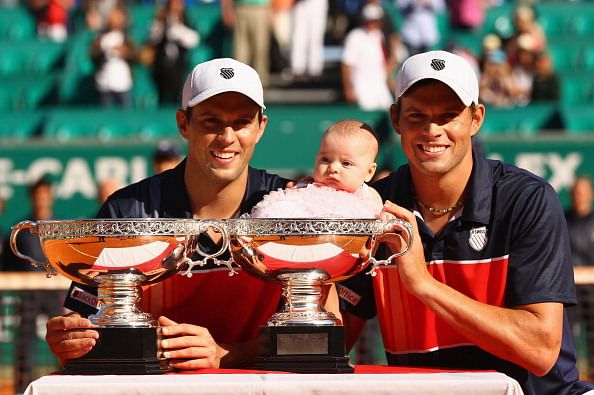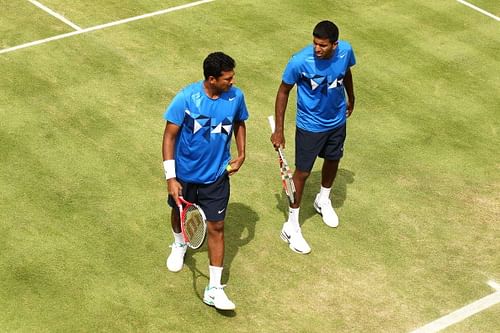
Why succeeding in doubles means giving up your singles ambitions

L-R Mike Bryan and Bob Bryan of the USA after victory in the doubles final against Max Mirnyi of Belarus and Daniel Nestor of Canada in the ATP Monte Carlo Masters,
The Bryan brothers, Daniel Nestor, Lisa Raymond and Liezel Huber are multiple Grand Slam tennis champions. Yet there aren’t mentioned in the same breath as other multiple Grand Slam champions like Roger Federer, Rafael Nadal, Novak Djokovic, Serena Williams or Maria Sharapova. That’s because their slams have come in doubles, rather than the high-profile world of singles.
Doubles specialists are often relegated to second class citizens in the tennis world. But make no mistake, for the ones who do make it to the top of the doubles game, there’s nothing second class about life as a doubles specialist.
The WTA’s current top ranked doubles duo, Sara Errani and Roberta Vinci, have raked in more than $1.7 million this year alone while the Bryan brothers, the ATP doubles leaders for several years now, have won more than $18 million combined in career prize money, almost exclusively in doubles.
It’s not surprising then that several players choose to focus exclusively on doubles. Doubles requires skills quite different from those in singles. In today’s game, to be a top singles player, one needs to have powerful groundstrokes, excellent court coverage and great defensive skills. In doubles, however, a good serve and good volleys, that almost extinct shot in the singles game, can take you a long way.
Also in doubles, you also need to cover only half the court and in recent years, several tournaments use a third set super tiebreaker rather than a regular third set – all this adding up to several more years in a players career when they focus only on doubles. Consider the age of some of today’s top doubles stars – Nestor is 40 years old, Raymond is 39, the same age as our very own Leander Paes while Mahesh Bhupathi is 38.
Some players become doubles specialists without ever making it big in the singles game. For others, it‘s a path that chooses them rather than the other way around. Most players have periods in their careers where their singles ranking drops due to loss of form or a serious injury which forces them to take a break. Often, when they come back, they find success in doubles much sooner than in singles. What follows then is a familiar script – A player is busy competing in the latter rounds of the doubles events on weekends and is not able to play the qualifying rounds of the singles events the following week. Also, choosing to play the prestigious doubles events often means that they do not make the ranking cut-off for the singles draws in those same events. And while their doubles ranking goes up, their singles ranking continues to nose dive. The player is then left with a big decision. Should they give up on doubles and the perks that come with it (the titles, the prize money) and prioritize only singles, without any guarantee of success? Or should they give up their singles ambitions and focus only on doubles, and continue to make a decent living on the fringes of big-time tennis.
Take the case of Sania Mirza, India’s top ranked player for more than 7 years now. When Sania underwent knee surgery towards the end of 2011, her singles ranking nosedived and when she did play, the lack of match fitness resulted in several first round exits. While her singles ranking plummeted, Sania continued to do well in doubles. Sania’s ranking could get her into only the low level ITF events and qualifying draws of WTA events. But the Indian needed to compete in the top doubles events in order to qualify for the Olympic Games. Wisely, Sania chose to focus on the doubles giving a complete backseat to her singles ambitions.
Currently, Sania is ranked a respectable no. 13 in the doubles while her ranking in singles is closer to 300. The 25 year old Indian is still unsure if she will play singles next year, knowing her body may not be able to take the strain of playing singles week-in week-out while her mind still thinks she is capable of playing top-flight singles. “I am tempted to play singles again and have been practising since the US Open. It’s tough and all about working day in and day out but I will take a call. A lot depends on my body, especially my knee. Besides, it does take a toll on one’s body and if I do play singles, then I have to go through the qualifiers and then I have to play doubles as well. Everything will depend if my knee can hold so much pressure,” commented Sania, who has been ranked as high as no. 27 in singles in 2007.

On the other hand, there’s Rohan Bopanna. The 32 year old Indian could make it only as high as no. 213 in singles way back in 2007 – the same year he won 4 challenger titles with Aisam Ul-Huq Qureshi. There was no looking back from there as the duo soon transitioned to the ATP circuit and went on to reach the US Open finals in 2010, becoming one of the top draw cards in doubles. Bopanna’s singles ranking never kept pace with his doubles ranking and the Indian did not take time off from doubles to play in the ITF events. Not surprisingly, Bopanna’s singles career never blossomed.
For 25 year old Divij Sharan, the choice was easier since doubles always came more naturally to the left hander. Divij could only get high as no. 438 in singles but this year, he has exploded in doubles – winning 2 doubles titles and reaching 5 more finals on the Challenger circuit. Divij cracked the top 100 doubles rankings a few weeks ago, and is now hoping to move on to the ATP circuit.
In a recent interview to Sportskeeda, Divij admitted, “I’ve always had more success in doubles since my junior days, so doubles comes naturally to me. So when the time came it wasn’t very tough to decide on focusing more on doubles. I still enjoy playing singles and try to play whenever I get the chance though my priorities still lie with doubles.”
Every young kid learning to play the game dreams of winning the Grand Slam singles title, becoming the world’s no. 1 ranked singles player and breaking the records set by Federer or Steffi Graf. No one dreams of becoming the next Woodies or the Martina Navratilova/ Pam Shriver combination of their era. But life has a funny way of taking us in directions we never intended to go in. In the famous words of Robert Frost,
“I shall be telling this with a sigh
Somewhere ages and ages hence: Two roads diverged in a wood, and I,
I took the one less traveled by,
And that has made all the difference.”